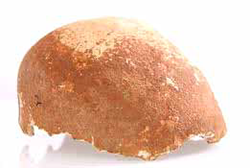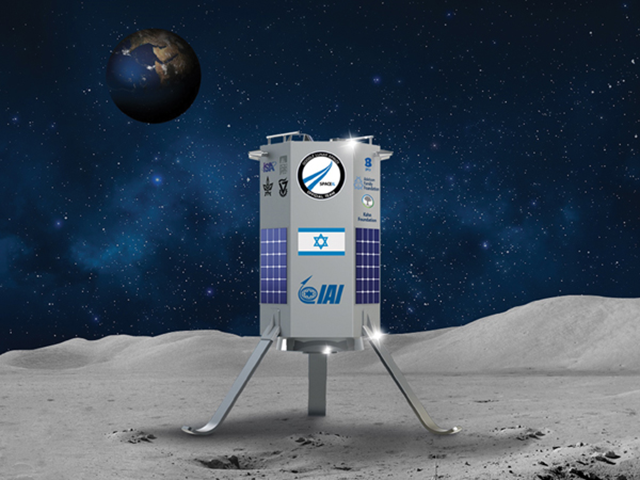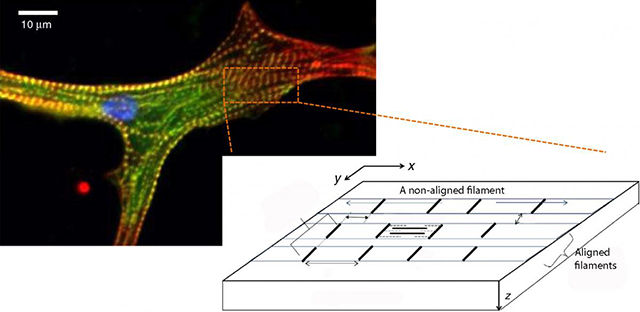When Age Matters; A Message to the Moon; In a Heartbeat; Women’s Postdoctoral Program Accepting Applications
When Age Matters
The precise dating of ancient charcoal found near a skull is helping reveal a unique period in prehistory

Manot Cave cranium
A partial human skull unearthed in 2008 in northern Israel may hold some clues as to when and where humans and Neanderthals might have interbred. The key to addressing this, as well as other important issues, is precisely determining the age of the skull. A combination of dating methods, one of them performed by Dr. Elisabetta Boaretto, head of the Weizmann Institute’s D-REAMS (DANGOOR Research Accelerator Mass Spectrometry) laboratory, has made it possible to define the period of time that the cave was occupied and, thus, the skull’s age. The combined dating provides evidence that Homo sapiens and Homo neanderthalensis could have lived side by side in the area.
The Manot Cave, a natural limestone formation, had been sealed for some 15,000 years. It was discovered by a bulldozer clearing the land for development, and the first to find the partial skull, which was sitting on a ledge, were spelunkers exploring the newly-opened cave. Five excavation seasons uncovered a rich deposit, with stone tools and stratified occupation levels covering a period of time from at least 55,000 to 27,000 years ago.
Dating the skull presented a number of difficulties. “Because it was already removed from the layer where it was presumably deposited,” says Dr. Boaretto, “we had to look for clues to tell us where and when it belonged in the setting of the archaeological record in the cave.”
The age of the skull was first determined to be 54.7 thousand years old by a technique known as the uranium-thorium method, which was applied to the thin mineral deposit on the skull. But the estimated possible error in that type of method is plus or minus 5.5 thousand years. To obtain independent confirmation of the date, a different type of dating was required, such as radiocarbon dating.
To narrow down the possible range of the skull’s age and determine when its owner had lived in the cave, the archaeological team – led by Prof. Israel Hershkovitz of Tel Aviv University, Dr. Ofer Marder of Ben Gurion University, and Dr. Omry Barzilai of the Israel Antiquities Authority – turned to Dr. Boaretto. She and her group participated in the excavation of the cave and applied radiocarbon dating to carefully selected charcoal remains, so that the whole cave, and thus the timing of human occupation, was mapped. The agreement between the two methods – carbon and uranium-thorium – provided the necessary support for the “correction” in the original dating of the skull, helping fix the true age of the skull at around 55,000 years.
The date and shape of the Manot Cave skull provides some intriguing evidence that humans and Neanderthals might have interbred sometime during the human trek out of Africa, most likely as the former passed through the Middle East before spreading out to the north and east. The 55,000-year-old partial skull is the first evidence of a human residing in the region at the same time as Neanderthals, whose remains have been found at several nearby sites. Archaeologists are now searching for more evidence of ancient human habitation in the cave. If, indeed, the mixing between humans and Neanderthals took place in this area, it would suggest that the owner of the skull and his kin may have been the ancestors of all modern non-Africans.
For the scientific paper, click here.
A Message to the Moon
SpaceIL and the Weizmann Institute will host an online space trivia game leading up to Science Education Week

SpaceIL – a nonprofit organization dedicated to landing the first Israeli spacecraft on the Moon – and the Weizmann Institute of Science will be hosting an online game full of fun and prizes. This interactive space trivia game, “Super Moon,” will test participants’ knowledge of the solar system, the Moon, space exploration, and, of course, the unmanned mission that SpaceIL plans to send to the Moon. The game will launch online at the beginning of March 2015, and the winners will be announced during Science Education Week at the Weizmann Institute (March 22-29).
Super Moon will be offered to two age groups: 6-11 and 12-18. All entrants will win the opportunity to send a personal message to the Moon. The winners of the game will get the chance to join the SpaceIL team: They will receive official SpaceIL shirts and become members of the organization’s “young advisers” forum, a focus group for its educational activities.
In addition to the game, SpaceIL will be offering a series of activities on the Weizmann campus over the course of the Science Education Week. These include a workshop focused on the scientific experiment planned by SpaceIL to explore the Moon’s magnetic field; it will have participants looking for magnetic properties in rocks they find in the Clore Garden of Science. Another workshop will be given for teachers, and a number of lectures will be offered to the general public on the subject of the Israeli “space race.”
SpaceIL was founded at the end of 2010 by three young engineers – Yariv Bash, Kfir Damari, and Yonatan Weintroub – to compete in the Google Lunar XPrize competition, an international race to the Moon. The first prize is $20 million; the only Israeli team out of 18 teams competing, SpaceIL is building a very small, very smart spacecraft for its landing. SpaceIL is committed to using any potential prize money to promote science and science education in Israel, with the aim of ensuring that Israel will continue to live up to its reputation for excellence in these fields. Through this mission, SpaceIL aspires to create a new "Apollo effect," inspiring the next generation to think differently about science, technology, engineering, and math (STEM).
Prof. Oded Aharonson and Dr. Avi Barliya of the Weizmann Institute’s Department of Earth and Planetary Sciences, who lead the SpaceIL science experiment team, will be participating in the activities.
In a Heartbeat

A chicken heart-muscle cell under a fluorescent microscope; the filaments consist of repeated subunits (bright dotted lines). The schematic representation shows three neighboring filaments; the black lines are the boundaries of their subunits, such that the lower filament is aligned with the middle one, while the upper one is not.
Two hearts, said Keats, can beat as one, but a study led by Weizmann Institute scientists in collaboration with researchers from the University of Pennsylvania shows that sometimes a single heart muscle cell can beat as more than two dozen. The findings, reported recently in Nature Communications, provide an extremely detailed glimpse into the mechanisms behind normal and irregular heart muscle cell contractions. The study may help define the limitations of existing therapies for abnormal heartbeat and, in the future, suggest ways of designing new ones.
Each heart muscle cell consists of numerous parallel filaments comprising repeated subunits. When the heart beats, each individual filament contracts to produce muscle cell contractions.
Optimally, all the filaments should contract in a synchronized manner, thus ensuring the greatest amplitude of contraction for each muscle cell and ultimately, the strongest and most effective beating of the entire heart. However, a new theoretical model proposed and analyzed by Prof. Samuel Safran and postdoctoral fellow Dr. Kinjal Dasbiswas of the Weizmann Institute’s Department of Materials and Interfaces suggests that the filaments contract together only when their subunits, and subunit boundaries, are aligned with one another. Since such alignment usually only happens among a limited number of neighboring filaments, these contract together as a bundle -- however, each such bundle contracts out of phase with others. Therefore, a heart cell does not necessarily beat as a single uniform entity; rather, the number of different beating entities in the cell depends on the bundle number, which may reach more than two dozen.
The theory, which uses the methods of statistical physics, further predicted that the alignment of the filaments in the heart muscle cell depends on the cell’s physical environment, and more specifically on the elasticity of the supporting structure (called the extracellular matrix). The alignment is best when this structure is not too soft and not too rigid. The prediction took into consideration various forces operating on the microscale, particularly mechanical forces that are exerted on each filament subunit by neighboring filaments via the extracellular matrix.
By assuming that only structurally aligned filaments beat together, the Weizmann theorists were able to quantitatively explain experimental findings by their collaborators from the University of Pennsylvania (aka Penn), Prof. Dennis Discher and Dr. Stephanie Majkut. In the experiments, the Penn scientists had placed embryonic heart cells from chicks on support surfaces of varying stiffness, and found that two strikingly different properties – the structural alignment of the filaments and the beating strength of the cell – depended on the rigidity of the supporting surface.
By providing a theoretical basis for these experiments, the Weizmann model may help explain how filaments become aligned in heart muscle cells during embryonic development, and how their arrangement correlates with the muscle function in the adult heart.
This correlation suggests that the current means of treating irregular heartbeat may be limited to a certain extent by the structural order of heart muscle filaments – however, the new understanding may one day help design improved treatments for heart disease. For example, in the future, if new heart cells are grown to replace diseased ones, their growth environment may be manipulated so that their structure is well ordered and, to paraphrase Keats, all their filaments beat as one.
Prof. Samuel Safran’s research is supported by the Gerhardt M.J. Schmidt Minerva Center on Supramolecular Architectures, which he heads; the US-Israel Binational Science Foundation; the Israel Science Foundation; Antonio and Noga Villalon, Winnetka, IL; the Clore Center for Biological Physics; the Kimmelman Center for Structural Biology; and the Kimmel Stem Cell Research Institute. Prof. Safran is the incumbent of the Fern and Manfred Steinfeld Professorial Chair.
Dr. Kinjal Dasbiswas’s research is supported by a fellowship from the Council of Higher Education.
Women’s Postdoctoral Program Accepting Applications
The Israel National Postdoctoral Program for Advancing Women in Science, an initiative of the Weizmann Institute of Science, offers financial support to outstanding women scientists to help them get started on their careers. This year, ten grants will be awarded. These will give the selected scientists up to $20,000 a year to help them move abroad to work in the world's most prestigious labs; importantly, the funds may be used by the scientist in whatever manner she chooses.
The grants are given to women with PhDs in the natural and exact sciences from any academic institution in Israel; these must have been approved before Jan. 1, 2014. Applications will be accepted until May 1, 2015.
The Weizmann Institute established the Israel National Postdoctoral Program for Advancing Women in Science in 2007. The program's goal is to get more women into careers in science by helping them through the critical period of postdoctoral research. Even the most outstanding women scientists may be stymied by the need to conduct this research outside of Israel, which often involves moving a whole family. The grantees have no obligation to return to an academic institution in Israel; of those who have completed the program, 38 have remained in academic positions outside the country and 27 are now leading research groups in Israeli institutes. Another 47 are currently still conducting postdoctoral research abroad.
“This is a prestigious, pioneering program with a vision that encompasses national priorities,” says Prof. Daniella Golfarb, the President’s Adviser for Advancing Women in Science. “The monetary prize, of course, gives financial security to these young women, so they can go abroad for their postdoctoral fellowships even if their spouses do not have a job lined up. But in addition to the money, the grantees get the encouragement they need to say to themselves and the world: ‘I am good at what I do; I’ve got an investment in me that says I can succeed.’”
For more information: http://wws.weizmann.ac.il/WomenInScience/
